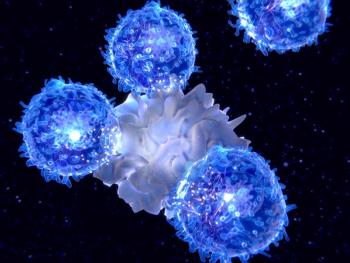
Oncology NEWS International
- Oncology NEWS International Vol 10 No 2
- Volume 10
- Issue 2
Rituximab Is Highly Active in Lymphocyte Predominance Hodgkin’s Disease
STANFORD, California-Rituximab (Rituxan) is highly active in achieving clinical response in lymphoctye predominance Hodgkin’s disease (LPHD) and may ultimately have the potential of reducing long-term side effects and improving survival in this disease, according to the results of a phase-II trial. Although LPHD has effectively been treated with radiotherapy, chemotherapy, or a combined modality, a subset of patients experiences recurrence and treatment related morbidity and mortality-often from heart disease.
STANFORD, CaliforniaRituximab (Rituxan) is highly active in achieving clinical response in lymphoctye predominance Hodgkin’s disease (LPHD) and may ultimately have the potential of reducing long-term side effects and improving survival in this disease, according to the results of a phase-II trial. Although LPHD has effectively been treated with radiotherapy, chemotherapy, or a combined modality, a subset of patients experiences recurrence and treatment related morbidity and mortalityoften from heart disease.
In the multicenter study of 13 patients, including 11 evaluable at the end of the trial, the response rate was 100%, according to lead researcher Jennifer B. Lucas, MD, of Stanford University Medical Center in California. Seven patients had a complete response and four patients showed a partial remission, Dr. Lucas reported.
LPHD is a subtype of Hodgkin’s disease that expresses the CD20 antigen. "We hypothesized that this new biological agent would be efficacious and reduce the long-term side effects that often arise with this disease," Dr. Lucas said. "As it turned out, the study showed rituximab to be a highly active drug in the treatment of LPHD."
Study Design
All 13 of the patients received a rituximab dose of 375 mg/m2 once weekly for 4 weeks. Restaging studies were then performed at 6 weeks, and at 3, 6, and 12 months following therapy.
As is generally true in LPHD, most patients (nine) were males. Eight patients had untreated disease, and five had relapsed disease. Among the previously untreated patients, four had stage-III disease. The median age was 39 years and disease sites included the neck, axilla, mediastinum, iliac, inguinal/femoral, and spleen.
Dr. Lucas said the researchers headed off potential criticism of their study by developing carefully written guidelines for supplying standard therapy in a timely fashion should any of the patients relapse after rituximab. Patients who had a history of relapse after standard therapy, and who initially responded to rituximab for more than 6 months, were eligible for re-treatment with rituximab.
One patient progressed after a partial response to rituximab. This patient then was re-treated and has achieved a partial response at 3 months follow-up, according to Dr. Lucas.
In a 36-year-old female patient with recurrent disease, lymph nodes shrank to less than a centimeter after therapy, "demonstrating a nice response to rituximab," Dr. Lucas said.
No Significant Toxicity
Rituximab treatment was well tolerated by most patients, and produced no significant toxicity. There was no grade 3 or 4 toxicity, Dr. Lucas added.
"The study supports our hypothesis that not only is this agent efficacious in LPHD patients, but it may be a medication that reduces long-term toxicity," Dr. Lucas stated.
Dr. Lucas pointed out that the results of this study should be considered carefully in light of the fact that these tumors have a large population of normal inflammatory B cells, with the tumor cells scattered among the normal cells. Rituximab targets both the tumor cells and the normal host B cells. Therefore a clinical response may be seen by just reducing the normal B cells in the tumor mass. Accordingly, further investigation and longer follow-up is warranted to assess durability of response.
Clinicians should think about combining antibody treatment and standard therapy to maximize efficacy and minimize long-term side effects for LPHD patients, Dr. Lucas commented. "In patients with more symptomatic or extensive disease, consideration should also be given to rituximab vs transplantation with its accompanying toxicity," Dr. Lucas advised.
The study was supported by Genentech, Inc., which manufactures and markets Rituxan, and by IDEC Pharmaceuticals.
Articles in this issue
almost 25 years ago
Activated T Cells Can Alter Behavior of Leukemic B Cellsalmost 25 years ago
Response Continues for at Least 8 Months with Ibritumomab Tiuxetanalmost 25 years ago
Synthetic Anthracycline Produces High Response Rates in SCLCalmost 25 years ago
Ibritumomab Tiuxetan Produces 73% Response Rate in B-cell NHLalmost 25 years ago
G-CSF Might Prolong Rituximab Responses in NHLalmost 25 years ago
Use of CAD Increases the Early Detection of Breast Cancer by 20%almost 25 years ago
Rituximab Plus Fludarabine May Be Good Alternative to Rituximab Plus CHOPNewsletter
Stay up to date on recent advances in the multidisciplinary approach to cancer.

















































































